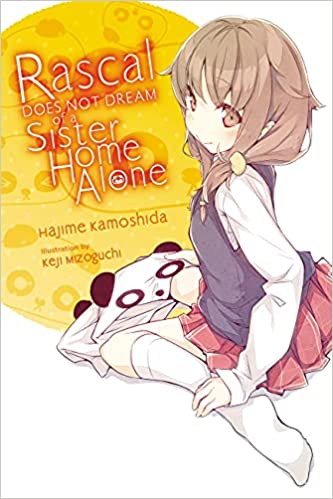By Hajime Kamoshida and Keji Mizoguchi. Released in Japan as “Seishun Buta Yarou wa Orusuban Imouto no Yume wo Minai” by Dengeki Bunko. Released in North America by Yen On. Translated by Andrew Cunningham.
The first four books of the series had its main character, Sakuta, helping out a different girl each time who had what he termed “Adolescence Syndrome”, where an inner issue they were suffering from showed itself in an exterior way. Mai was turning invisible, Tomoe was time looping, Rio twinned herself, and Nodoka bodyswapped herself with her sister. Through all this, though, we were also learning of Sakuta’s own past – both his encounter with a high school girl named Shouko (who he rediscovers but not in high school) and his sister, whose reaction to bullying, and his frustration and reaction to her own pain, is what jumpstarted all of this. Now, at last, in this 5th book, we finally get to focus on Kaede. She’s more determined than ever to leave the apartment and go to school, to the point where she has a list of tasks in her diary. Together with Sakuta, can she succeed? Well, yes, but that’s not necessarily a wonderful thing for all involved.
Much of this book is about moving forward and trying to take a next step. For Sakuta that means actually applying himself. Mai, despite her celebrity, is going to college, and Sakuta wants to follow her there a year later. For Kaede, this means a whole lot of things. Just going to school is fraught with tensions, given that whenever she sees someone she doesn’t know, especially someone wearing her school uniform, she has a panic attack. She’s also re-exhibiting signs of her adolescence syndrome, which is definitely not a good thing. (Given that when this happened before, the authorities thought her mother abused her, I worried they might zero in on Sakuta, but thankfully this does not go there.) And there’s another, even larger issue: Kaede, as we discover here, has no memories from before two years ago. Given the way amnesia works, there’s a danger that she might lose herself no matter what the outcome.
There is a large chunk of this book that is very heartwarming. Seeing Kaede’s determination is great, trying to take small steps despite her terror. Sakuta strikes exactly the right notes, knowing when to push and when to retreat. The scenes at the zoo were magical, and brought a smile to your face… which of course makes the last fifth of the book all the more tear-jerking. It’s startling to see not just Kaede but also Sakuta re-develop symptoms from adolescence syndrome, and of course it happens when Mai is out of the city and can’t help him. Fortunately, he has Shouko – the older version – to help him once again. That said, she’s not Mai, and I wish that Mai had been there to talk him out of it. Mai remains the best part of this series. In any case, I’m not sure where Sakuta’s family relationship will go from here, but hopefully his romantic relationships will survive the cliffhanger. They probably will, she’s eminently sensible.
I joked on Twitter that the next two books would be light and fluffy – trust me, I saw the movie reviews, and while I don’t know what’s going to happen I know it’s a tear jerker. But so is this, in its own way, as we take a look at what makes up a person’s identity, and how fragile that can really be.


Speak Your Mind